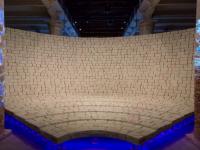Delhi Art Gallery
Mumbai, India
The Delhi Art Gallery, Mumbai is a four level gallery that sits in a century old building in Kala Ghoda, a very important, lively and historic precinct of Mumbai. It showcases art works on the ground and first floors. The other two levels host the gallery’s permanent collection, a sculpture courtyard cum auditorium, private lounges and gallery offices. The building was abused and defaced beyond recognition; hence we were compelled to treat it like a heritage restoration project, whilst enough cues from well preserved surrounding buildings were available for us to build on. The usage was quite contemporary- an Art Gallery, which by its function needs to be minimalist. The challenge was to recreate the heritage value but not imitate in an anachronistic way. Adaptive reuse was adopted to achieve the right balance and was our primary design agenda. Beyond that, the construction itself and the preservation of the original elements were challenging in many ways, as this building had been formed and reformed so many times on the inside that as layers were peeled off, more and more discovery happened. Eventually it was very satisfying to reinstate the heritage value of the project and do justice to the term Adaptive Reuse. The DAG Mumbai now stands prominently at the char-rasta at Kala Ghoda, juxtaposed with the amazing Blue Synagogue across it.
The exterior almost went through reconstructive surgery after years of defacing were peeled off. It was reconstructed from scratch taking inspiration from the original wrought iron and stucco that remained and motifs were borrowed and extrapolated from surrounding buildings- which tend to be floral, yet arranged in geometric and rhythmic patterns. In keeping with the heritage spirit, signage- a modern day necessity was deftly interwoven into the details. The half-broken pilasters were recreated to conceal and embed services within them. It was a time consuming and laborious exercise, but well worth the end result.
On the inside, just stripping the building of all additions over time and bringing back its original volume was a challenge, and a structural challenge too. Additionally, subterranean water was rising through the building, creating damp and termite ridden walls. Technically, dealing with that without bringing the structure down was an intricate task. Today if you look at the spacious stairs that people move up and down one would be hard pressed to believe that we couldn’t even take a painting up on our first visit. Moving through the tight staircases posed its own set of problems for the workers on site. The ceilings within were made at two separate points in time, each with a different construction methodology. Both were rafters, one in stone and the other in wood. To unify the two styles, expose them, as they talk of the building’s history, was a design challenge that we successfully addressed. Shortage of space was addressed through doubling wall space by partitioning each floor, yet retaining daylight and the desired scale.
We believe that DAG Mumbai could be the example for rejuvenating other derelict historic districts in Urban India.












